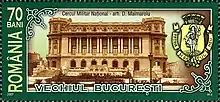Dimitrie Maimarolu
Dimitrie Maimarolu (1859 in Bucharest – 1926) was a Romanian architect, whose designs featured French Beaux-Arts style.

Poșta Română stamp from 2007 depicting the Palace of the National Military Circle, designed by architect Dimitrie Maimarolu
He came from an Aromanian family, with roots in Macedonia.[1] He studied architecture in France, first with Julien Guadet and from 1881 at the École des Beaux-Arts in Paris. After graduating in 1885, he returned to Romania and is named architect for the Interior Ministry. Promoted to architect-in-chief in 1887, he held the position until 1892. By 1898 he was working for the Agriculture Ministry, developing the Bibescu Garden in Craiova.[2]
Among the buildings he designed are:
- Argeș County Prefecture Building (built in 1899, in 1970 it became the County Museum of History and Natural Science).[3]
- Gorj County Prefecture, in Târgu Jiu (finishing touches, 1902).[4]
- Church of St. Sylvester, Bucharest (reconstruction and enlargement, from 1904 to 1907).[5]
- St. Haralambos Church of Turnu Măgurele (1905)[6]
- Palace of the Chamber of Deputies (the Patriarchal Palace today), completed in 1907[7]
- Palace of the National Military Circle, begun in 1911, completed in 1923.[8]
- Armenian Church in Bucharest, 1911–1912, with Grigore Cerchez[9][10]
- Hotel Concordia.[10]
- Vorvorenilor's Home (Palace) in Craiova (present residence of the Metropolitan of Oltenia)[11][12]
Legacy
On 1 March 2005, a bust of Maimarolu was unveiled within the National Military Circle Palace.
Notes
- "Mari aromâni în Istoria Neamului Românesc". www.justitiarul.ro (in Romanian). Justițiarul. Retrieved December 25, 2020.
- "Dimitrie Maimarolu". arhivadearhitectura.ro (in Romanian). Arhiva de Arhitectură. Retrieved December 24, 2020.
- "Muzeul Județean Argeș" [Argeș County Museum] (in Romanian). Consiliul Județean Argeș (Argeș County Council). Archived from the original on 4 November 2010. Retrieved 9 October 2012.
- "Clădiri administrative și de învățământ clasificate drept monument istoric, din Târgu Jiu". www.targujiu.info (in Romanian). Târgu Jiu Tourist Office. Retrieved December 24, 2020.
- "Biserica Sfântul Silvestru" (in Romanian). Creștin Ortodox România. Archived from the original on 1 July 2011.
- "Biserica Sf Haralambie - Turnu Magurele" (in Romanian). Destinații Turistice în România.
- Popescu, Carmen; Lascu, Nicolae (2004). "Bucharest, Romania". In Sennott, Stephen (ed.). Encyclopedia of Twentieth Century Architecture. Taylor & Francis. p. 182.
- Iosif, Cristina. "The National Military Circle (The Officers' Circle Palace, 1911-1923)". Unknown Bucharest.
- "Catedrala armeană" (in Romanian). Uniunea Armenilor Romania. 16 September 2011. Archived from the original on 9 October 2012. Retrieved 9 October 2012.
- "Arhitecții Catedralei" (PDF). Ararat (new series) (in Romanian). 16 (20): 4. 2005. Archived from the original (PDF) on 2012-10-09.
- "Craiova" (in Romanian). Romania Turistica. Archived from the original on 1 June 2010.
- Cocea, Cristian (2005). Ghidul României misterioase (Guide to Mysterious Romania) (in Romanian). Pitești, Romania: Paralela 45. p. 82. ISBN 978-973-697-533-2.
This article is issued from Wikipedia. The text is licensed under Creative Commons - Attribution - Sharealike. Additional terms may apply for the media files.